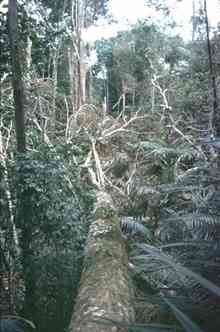Violent winds in a squall line of a single storm in January of 2005 killed half a billion trees in the Amazon forest, according to the first "body-count" of its kind.
 The study of the aftermath of the destruction -- noticeable even on satellite images -- contradicts earlier findings that blamed the huge 2005 die-off throughout the basin exclusively on drought. Authors of the new research observed that a large area of tree loss in the Central Amazon had not been affected by a dry spell.
The study of the aftermath of the destruction -- noticeable even on satellite images -- contradicts earlier findings that blamed the huge 2005 die-off throughout the basin exclusively on drought. Authors of the new research observed that a large area of tree loss in the Central Amazon had not been affected by a dry spell.
After studying changes in the "woody signal" of Landsat satellite images, the international team of researchers established five field sites in the Manaus region of the central Amazon and closely examined the downed trees.
"If a tree dies from drought, it generally dies standing," co-author Jeffrey Chambers, a forest ecologist at Tulane University, said in a joint release issued by the American Geophysical Union and Tulane. "It looks very different from trees that die snapped by a storm."
In areas hardest hit by the storm, the researchers found up to 80 percent of the trees snapped or uprooted by downdrafts estimated at 90 miles per hour as the storm swept over the Amazon in 2005. The team calculated the tree loss from that single event at up to 500,000 in the Manaus region alone, and estimated that between 441 and 663 million trees were killed by the storm across the basin.
The great rainforest of the Amazon basin is an important player in the global carbon cycle -- both a "sink" and a source of atmospheric carbon dioxide -- and is the subject of numerous studies related to our changing climate and a future of global warming. Earlier studies attributing all of the big 2005 die-off to drought were not based on field work that examined the cause of the death of individual trees.
Author of one such study, Professor Oliver Phillips at Leeds University in the UK, told Discovery News the new research describes "an interesting phenomenon, but its basin-wide implications are unclear and I don't see any conflict with our work."
"We observed that across Amazonia the probability of tree death during 2005 increased in direct proportion to the rainfall deficit experienced locally," he said. Moreover, "we were able to also determine that forests which did not experience drought did not, on average, experience extra mortality."
Still, the new study introduces an intriguing, abrupt time element to the mix of causes and effects.
"Under a changing climate, some forecasts say that storms will increase in intensity," said Tulane's Chambers. "If we start seeing increase in tree mortality, we need to be able to say what's killing the trees."
Author: John D. Cox | Source: Discovery News [July 13, 2010]





